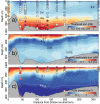Modeling the Seasonal Cycle of Iron and Carbon Fluxes in the Amundsen Sea Polynya, Antarctica
- PMID: 35865970
- PMCID: PMC9285801
- DOI: 10.1029/2018JC014773
Modeling the Seasonal Cycle of Iron and Carbon Fluxes in the Amundsen Sea Polynya, Antarctica
Abstract
The Amundsen Sea Polynya (ASP) is distinguished by having the highest net primary production per unit area in the coastal Antarctic. Recent studies have related this high productivity to the presence of fast-melting ice shelves, but the mechanisms involved are not well understood. In this study we describe the first numerical model of the ASP to represent explicitly the ocean-ice interactions, nitrogen and iron cycles, and the coastal circulation at high resolution. The study focuses on the seasonal cycle of iron and carbon, and the results are broadly consistent with field observations collected during the summer of 2010-2011. The simulated biogeochemical cycle is strongly controlled by light availability(dictated by sea ice, phytoplankton self-shading, and variable sunlight). The micronutrient iron exhibits strong seasonality, where scavenging by biogenic particles and remineralization play large compensating roles. Lateral fluxes of iron are also important to the iron budget, and our results confirm the key role played by inputs of dissolved iron from the buoyancy-driven circulation of melting ice shelf cavities (the "meltwater pump"). The model suggests that westward flowing coastal circulation plays two important roles: it provides additional iron to the ASP and it collects particulate organic matter generated by the bloom and transports it to the west of the ASP. As a result, maps of vertical particulate organic matter fluxes show highest fluxes in shelf regions located west of the productive central ASP. Overall, these model results improve our mechanistic understanding of the ASP bloom, while suggesting testable hypotheses for future field efforts.
Keywords: Antarctica; ice shelves; oceanography; phytoplankton; polynyas; sea ice.
©2019. The Authors.
Figures













Similar articles
-
Carbon and Iron Uptake by Phytoplankton in the Amundsen Sea, Antarctica.Biology (Basel). 2022 Dec 4;11(12):1760. doi: 10.3390/biology11121760. Biology (Basel). 2022. PMID: 36552270 Free PMC article.
-
Freshening by glacial meltwater enhances melting of ice shelves and reduces formation of Antarctic Bottom Water.Sci Adv. 2018 Apr 18;4(4):eaap9467. doi: 10.1126/sciadv.aap9467. eCollection 2018 Apr. Sci Adv. 2018. PMID: 29675467 Free PMC article.
-
Characteristics of the horizontal and vertical distributions of dimethyl sulfide throughout the Amundsen Sea Polynya.Sci Total Environ. 2017 Apr 15;584-585:154-163. doi: 10.1016/j.scitotenv.2017.01.165. Epub 2017 Jan 29. Sci Total Environ. 2017. PMID: 28147295
-
Ecology of southern ocean pack ice.Adv Mar Biol. 2002;43:171-276. doi: 10.1016/s0065-2881(02)43005-2. Adv Mar Biol. 2002. PMID: 12154613 Review.
-
Trace metals in Antarctica related to climate change and increasing human impact.Rev Environ Contam Toxicol. 2000;166:129-73. Rev Environ Contam Toxicol. 2000. PMID: 10868078 Review.
Cited by
-
Seasonal Dynamics of Dissolved Iron on the Antarctic Continental Shelf: Late-Fall Observations From the Terra Nova Bay and Ross Ice Shelf Polynyas.J Geophys Res Oceans. 2022 Oct;127(10):e2022JC018999. doi: 10.1029/2022JC018999. Epub 2022 Oct 17. J Geophys Res Oceans. 2022. PMID: 36590600 Free PMC article.
-
The 79°N Glacier cavity modulates subglacial iron export to the NE Greenland Shelf.Nat Commun. 2021 May 24;12(1):3030. doi: 10.1038/s41467-021-23093-0. Nat Commun. 2021. PMID: 34031401 Free PMC article.
-
Ecological Importance of Viral Lysis as a Loss Factor of Phytoplankton in the Amundsen Sea.Microorganisms. 2022 Oct 5;10(10):1967. doi: 10.3390/microorganisms10101967. Microorganisms. 2022. PMID: 36296243 Free PMC article.
-
A dataset of the daily edge of each polynya in the Antarctic.Sci Data. 2024 Sep 17;11(1):1006. doi: 10.1038/s41597-024-03848-2. Sci Data. 2024. PMID: 39289369 Free PMC article.
-
Carbon and Iron Uptake by Phytoplankton in the Amundsen Sea, Antarctica.Biology (Basel). 2022 Dec 4;11(12):1760. doi: 10.3390/biology11121760. Biology (Basel). 2022. PMID: 36552270 Free PMC article.
References
-
- Alderkamp, A. C. , Mills, M. M. , van Dijken, G. L. , Laan, P. , Thuroczy, C. , Gerringa, L. J. , & Arrigo, K. R. (2012). Iron from melting glaciers fuels phytoplankton blooms in the Amundsen Sea (Southern Ocean): Phytoplankton characteristics and productivity. Deep‐Sea Research II, 71‐76, 32–48. 10.1016/j.dsr2.2012.03.005 - DOI
-
- Alderkamp, A. C. , van Dijken, G. L. , Lowry, K. E. , Connelly, T. L. , Lagerstrom, M. , Sherrell, R. M. , & Arrigo, K. R. (2015). Fe availability drives phytoplankton photosynthesis rates during spring bloom in the Amundsen Sea Polynya, Antarctica. Elementa: Science of the Anthropocene, 3(43), 43. 10.12952/journal.elementa.000043 - DOI
-
- Arrigo, K. R. , Lowry, K. E. , & van Dijken, G. L. (2012). Annual changes in sea ice and phytoplankton in polynyas of the Amundsen Sea, Antarctica. Deep Sea Research II, 71‐76, 5–15. 10.1016/j.dsr2.2012.03.006 - DOI
-
- Arrigo, K. R. , van Dijken, G. L. , & Strong, A. L. (2015). Environmental controls of marine productivity hot spots around Antarctica. Journal of Geophysical Research: Oceans, 120, 5545–5565. 10.1002/2015JC010888 - DOI
-
- Aumont, O. , Ethé, C. , Tagliabue, A. , Bopp, L. , & Gehlen, M. (2015). PISCES‐v2: An ocean biogeochemical model for carbon and ecosystem studies. Geoscientific Model Development, 8, 465–2513. 10.5194/gmd-8-2465-2015 - DOI
LinkOut - more resources
Full Text Sources
Research Materials
